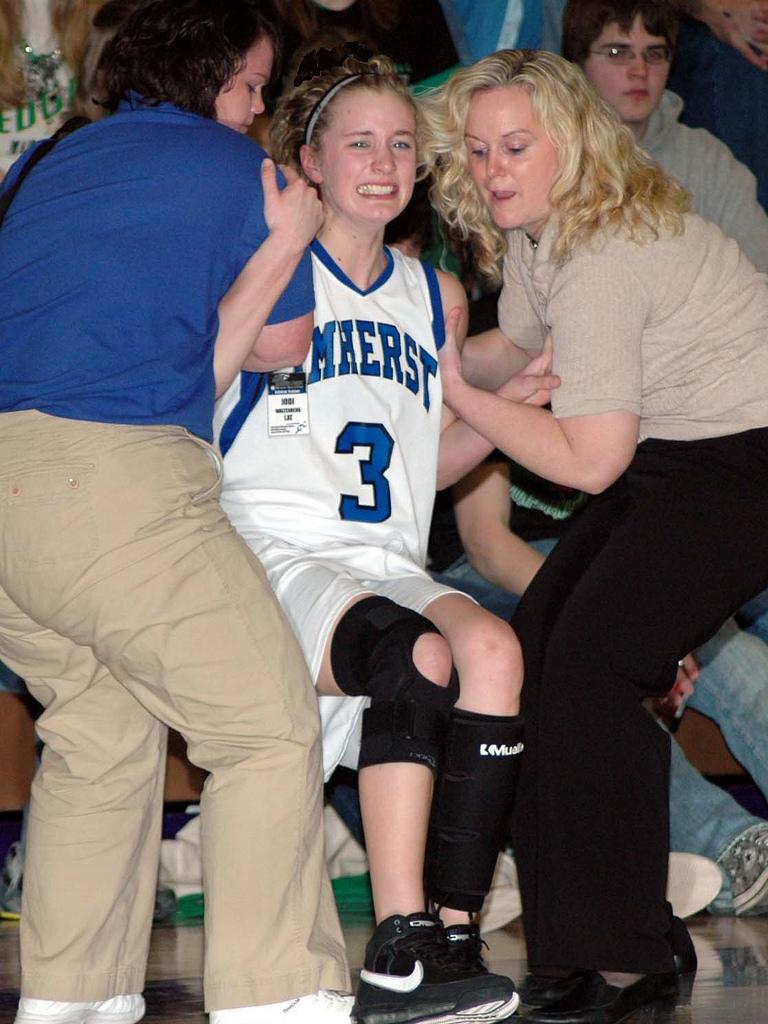
Many more kids than ever before are suffering permanently debilitating sporting injuries – the kinds of injuries that only hard-core sporting adults worried about in the past. And the science says that bottle of blue goop the kids swill at half time is likely to be the cause.
The dreaded ACL injury is a tear in the anterior cruciate ligament, one of the four ligaments that hold our knee together. The ACL is inside the knee joint connecting the bottom of the thigh bone (the femur) to the top of the lower leg bone (the tibia). It is attached to the tibia by a little spit of bone called the tibial spine.
Twenty years ago kids didn’t tear their ACL, they broke the tibial spine. This was because in growing children the bones are not at full strength, but the ligaments are. In a stressed situation, where the ACL is yanking on the tibial spine, the bone gave way before the ligament, hence the fracture.
Orthopaedics textbooks from the nineties warned doctors to look for tibial spine fractures because children don’t tear their ACLs. In essence, they thought they were immune to ACLs by virtue of being children.
But that has all changed swiftly, and not just in children. The numbers of people suffering ACLs has been rapidly increasing in the last two decades. The rate increased by a third between 1996 and 2004 (and almost doubled in women in that period). The increase was even more dramatic in children under 17 years of age.
One recent detailed review at just one US hospital found ACL tears in children increased by 11% every year between 1999 and 2011. In the same period the numbers of tibial spine fractures barely changed.
All of a sudden our kids are not making ligaments strong enough to break their developing tibial spine’s – the ligament tears instead.
Even after adjusting for increases in sports participation there is a very nasty (for the victims and the health system) trend developing at very high speed.
ACL’s can be repaired (by transplanting other ligaments) but even a well repaired ACL is likely to have severely debilitating long term consequences. One recent study found that half of all adult Swedish soccer players who tore their ACL had developed severe arthritis of the injured knee within 14 years.
Apply that timeline to an 8 year old and it means they will spend most of their lives battling severe debilitation. And that’s from an injury that 8 year olds are supposed to be ‘immune’ to.
Fortunately there is good science that tells us why our ACLs are suddenly failing. Sugar.
The massive increase in our consumption of sugar is responsible for us producing substandard ligaments and cartilage. If we make knees out of rubbish material its little wonder that they are suddenly not up to the job.
Sometimes sugars we eat are accidentally attached to proteins by our body. When that happens, the process is called glycation. Glycation can result in the formation of all sorts of unpredictable (and haphazard) molecules called AGE’s (Advanced Glycation End-products).
All sugars can form AGE’s but the fructose half of table sugar (sucrose) is ten times as likely to do so as glucose (the other half).
Our bodies are used to garden variety (glucose-produced) AGE’s. And we are pretty good at breaking them down and disposing of them. But even so, over time they accumulate in our organs and tissues and we, well, age (the acronym AGE is very much on purpose).
Unfortunately the AGE’s made with fructose molecules are resistant to our disposal system. So not only they made at 10 times the rate, they hang around.
AGE’s are dangerous because they bond easily (and randomly) to each other and to other proteins in a process called cross-linking. Cross-linking significantly degrades the quality of the protein.
Long-lived proteins such as collagen, elastin (both used in ligaments), lens crystallins (used in the eyes) and cartilage are much more susceptible to the effects of AGEs because once we make a bad batch, they’re part of us for an awfully long time.
Collagen degraded by AGEs makes less elastic ligaments. And substandard ligaments, rather like rubber bands left in the sun, tear much more easily.
ACLs and other ligament and cartilage damage are now a standard part of sporting (and increasingly non-sporting – 30-40% occur while not playing sport) life because fructose is being consumed at unprecedented rates (ironically, particularly by those playing sport).
But here’s a tip, if you prefer to watch your kids on the sports field rather than in an ambulance, do what the NSW cricket team has just done and swap Gatorade for water.
Photo by Carolyn Tiry. Distributed under the Creative Commons License.

















This post is plausible.
One other possibility that might also contribute is non-slip courts
I find it difficult to understand why there is not any mention of synthetic surfaces and sports shoes designed to grab the surface rather than slide as we did 20 years ago. For example, netball. One only has to watch how the injuries happen and the lack of sliding to a stop and the constant pounding when landing on the hard surfaces, to understand that this is a significant component of modern knee and ankle injuries. Runners also suffer more shin splints. Young children are also training more times per week. Other relevant factors should be mentioned to gain intelligent attention to the sugar factor. It could cause sugar to be dismissed.
According to a 7:30 Report last night, Medicare data shows the number of Australian children undergoing ACL reconstructions has more than tripled in the past 15 years. http://www.abc.net.au/7.30/content/2016/s4575649.htm
I would love to see the paper on this sugar link. Do you have it handy?
The links are in the article
The paper is linked so well to many research papers. Not sure if it is just me but I can’t find the one that links the ACLs with sugar. I’d love to read it.
As I think I make clear in the article Di, I am simply drawing the logical conclusion based on what the research tells us about fructose AGE damage to collagen. That being said there are others that have come to the same conclusion for example: https://www.ncbi.nlm.nih.gov/pmc/articles/PMC4241420/ and there is quite a good review of the links between AGEs and tendon damage in this introduction to this population study https://www.researchgate.net/profile/Shihwei_Huang/publication/305679850_Diabetic_Mellitus_Increases_the_Risk_of_Rotator_Cuff_Tear_Repair_Surgery_A_Population-Based_Cohort_Study/links/57cb795508ae598251835aa0.pdf
[…] It’s not your imagination. Kids ARE getting hurt more while playing sports – This is an incredibly interesting article explaing why kids are tearing their ACL and MCLs when this was an unheard of injury just a few decades ago. Here’s a taste. “Twenty years ago kids didn’t tear their ACL, they broke the tibial spine. This was because in growing children the bones are not at full strength, but the ligaments are. In a stressed situation, where the ACL is yanking on the tibial spine, the bone gave way before the ligament, hence the fracture. Orthopaedics textbooks from the nineties warned doctors to look for tibial spine fractures because children don’t tear their ACLs. In essence, they thought they were immune to ACLs by virtue of being children.” […]
Udpate: New research from Australia shows “the annual incidence increased by 43% (from 54.0 to 77.4 per 100 000 population), and by 74% among those under 25 years of age (from 52.6 to 91.4 per 100 000 population). In males, the peak incidence in 2014–15 was for 20–24-year-olds (283 per 100 000 population); for females, it was for 15–19-year-olds (164 per 100 000 population). https://www.mja.com.au/journal/2018/208/8/increasing-rates-anterior-cruciate-ligament-reconstruction-young-australians